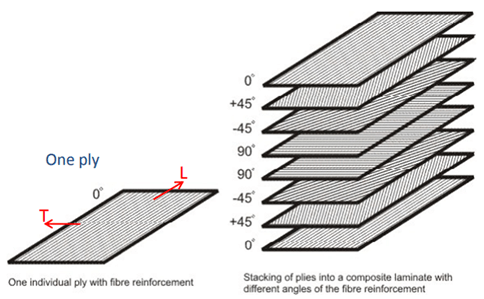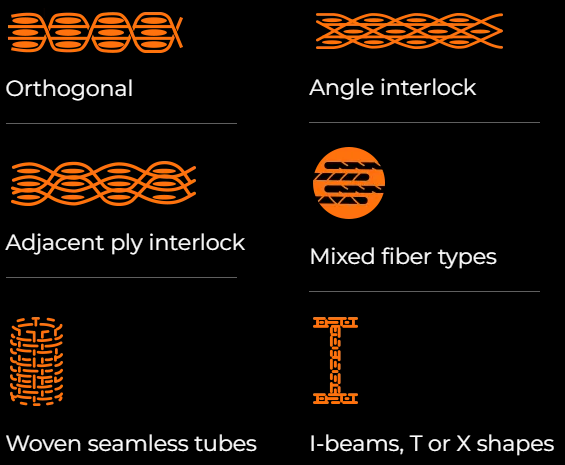COMPOSITES REINFORCED BY 3-DIMENSIONAL WOVEN FABRICS
In the vast majority of the fiber-reinforced composites used today, individual layers (plies), where each ply contains unidirectionally oriented continuous fibers in a polymer matrix, are stacked with different angles to form laminates. There is no reinforcing fiber between adjacent plies in such laminates so that they are held together solely by the matrix polymer. This conventional laminate layout is illustrated in the image below which is reproduced from slides posted by Professor André Preumont from the Université Libre de Bruxelles, Belgium.
 This conventional composite laminate layout suffers from some major disadvantages. Most important among these disadvantages is the fact that, due to the lack of reinforcement between them, adjacent plies are not held together nearly as strongly with each other as each individual ply is held within itself. Delamination is the most common mode of failure, and often the limiting factor in defining the performance envelope of a composite laminate, for this reason. In addition to delamination, conventional composite laminates are often prone to cracking. Finally, manufacturing a composite laminate with many layers is labor-intensive, increasing the production time and cost since each layer must be cut and placed.
This conventional composite laminate layout suffers from some major disadvantages. Most important among these disadvantages is the fact that, due to the lack of reinforcement between them, adjacent plies are not held together nearly as strongly with each other as each individual ply is held within itself. Delamination is the most common mode of failure, and often the limiting factor in defining the performance envelope of a composite laminate, for this reason. In addition to delamination, conventional composite laminates are often prone to cracking. Finally, manufacturing a composite laminate with many layers is labor-intensive, increasing the production time and cost since each layer must be cut and placed.
The development of composites where a polymer matrix is reinforced by a 3-dimensional (3D) woven fabric is a promising approach for avoiding these disadvantages. Composites incorporating well-designed 3D woven fabric reinforcements can provide reduced crack risk, better damage tolerance, and higher impact resistance than composites using the conventional layout summarized above. Composites reinforced by 3D woven fabrics provide these benefits by reducing the number of layers in a laminate and thus (most importantly) reducing the frequency of failures through delamination caused by an out-of-plane load or impact that leads to matrix failure and also as a further influence by reducing the crack risk.
In contrast to conventional composite laminates, composites reinforced by 3D woven fabrics have fiber reinforcement in the through-thickness direction. Such fabric designs generally result in very thick layers, comprising load-bearing fibers in the out-of-plane direction, and preventing delamination. Hence composites based on 3D woven fabrics can withstand heavier impacts than composites based on many layers of plies with unidirectionally oriented fibers while also offering the added benefit of requiring less labor to install.
Hearle and Chen, “3D Woven Preforms and Properties for Textile Composites”, ICCM International Conferences on Composite Materials (January 2009); Justusson et al., “Mechanical Testing of 3D Fabric Composites and Their Matrix Material SC-15”, Army Research Laboratory Report # ARL-TR-6245 (November 2012); Umer et al., “The Mechanical Properties of 3D Woven Composites”, Journal of Composite Materials, Volume 51, Issue 12, pages 1703-1716 (2016); and A. Saboktakin, M. Shahrouz, T. Vu-Khanh, and J. Bicerano, “X-ray Computed Tomography Characterization of 3D Tufted Twill Textile Composite for Aerostructures”, Journal of Harbin Institute of Technology, 26 (# 3), 7-13 (2019), are examples of scientific literature in this area.
Most new fiber-reinforced composites being manufactured today continue to be constructed by stacking individual unidirectionally oriented plies in different directions. Nevertheless, 3D woven fabrics suitable for reinforcing composites have also been commercialized by many manufacturers, and their applications are growing rapidly. We anticipate that they will be chosen over composites using a conventional layout with increasing frequency in the future.
The technologies of five manufacturers of 3D woven fabrics will be discussed below. In discussing each manufacturer, the related images have either been reproduced from the website of that manufacturer, or from additional product literature downloaded after filling out an online form on the website of the manufacturer, or provided by a representative of the manufacturer upon our request for inclusion in this post.
Albany Engineered Composites (AEC) is currently the biggest player in the market of composites reinforced by 3D woven fabrics. AEC has the ability to weave composite preforms in three dimensions, effectively weaving through-thickness reinforcements directly into a component during preform fabrication. The keys to the success of AEC’s 3D engineered composites are the design of the material system (the fiber and matrix materials that will be used), as well as of the fiber architecture which describes the directions and relative percentages of reinforcement. By controlling all of these factors, AEC is able to engineer components that meet specific performance goals while simultaneously satisfying component cost, qualification, certification, and eventual production needs. The aerospace and automotive applications of AEC’s technologies are continuing to grow. The advantages of AEC’s technology solutions in such applications include 30-50% weight reduction over metallic solutions, ability to design highly energy-absorbing structures, high durability, ability to satisfy impact and damage tolerance needs, ability to fabricate parts having complex geometries, ability to fabricate integrated structures, availability of simulation and computational analysis tools to support design and virtual prototyping, and both product prototyping/demonstration and full rate production capabilities for high value applications.


Bally Ribbon Mills (BRM) is another market leader in composites reinforced by 3D woven fabrics. The Advanced Product Group of BRM designs and produces woven structural shapes for hybrid composite structures used in aerospace applications, bridge structures, sporting gear, and medical equipment. To meet the demand for high-performance materials in advanced composite structures, BRM has developed a 3D continuous weaving method that produces multilayer textiles which can be fabricated into net-shape structures. For the design engineer involved in aircraft, satellite and missile applications, BRM’s advanced weaving capabilities offer new solutions to weight and cost problems. Another advantage of 3D weaving technology is the ability to weave complex shapes automatically, thereby eliminating the costly, time-consuming, and labor-intensive processes. The 3D composite structures developed for aerospace applications are lightweight, cost-effective, advanced woven composite 3D structures, such as 3D quasi-isotropic woven structures. The 3D continuous weaving technology has also enabled BRM to fabricate complex 3D woven joints such as “Pi – π,” double “T,” “H,” and other complex net shapes.


Tex Tech Industries produces 3D woven fabrics with uncrimped fibers to eliminate potential weaknesses in the material. The straight fibers in these woven fabrics lack stress-concentrating undulations, resulting in higher-strength products, while the Z-directional fibers provide enhanced toughness and resistance to delamination. Composites based on these 3D woven fabrics also perform well in replacing traditional materials, such as steel, without sacrificing durability or strength. Their high strength-to-weight ratio makes them ideal for industries such as transportation, heavy industrial, and marine. In addition to increasing strength and resistance, the use of these 3D woven fabrics can also shorten production times and thus provide significant cost savings. These 3D woven fabrics can also be produced with specialty fibers and materials for advanced composite applications such as fireproofing and ballistics protection. 3D woven fabrics are available from E-glass, S-glass, aramids such as Kevlar and Twaron, PAN carbon fibers, pitch carbon fibers, stainless steel yarns, and specialty fibers of materials such as alumina, silica, PE, and UHMWPE. The fiber architecture consists of stacked layers of yarns oriented in the 0º and 90º directions with one extra 90º layer. Through-thickness yarns, called Z-yarns, connect the 90º layers at the top and bottom surfaces to bind the fabric. The figure below provides a schematic illustration of the fiber architecture. The three figures below it show an actual fabric sample from three different perspectives.


Textum has developed many 3D fabrics. It holds exclusive rights to many patents on such fabrics. Textum’s 3D weaving technology enables fabrics to be woven to a specific width, length, and thickness, with three directions of fiber orientation. Multiple designs are possible; varying in the orientation of through-thickness fibers, yarn spacing, and/or fiber concentration in each weave direction. In most cases, the in-plane fibers do not interlace with each other but instead are layers of 0/90 fabric which are “stacked” on each other and held in place by through-thickness (or Z-direction) fibers. These multilayer fabrics are woven in such a way that the through-thickness yarns can be used for interlaminar property enhancement. These fabrics can be woven with a width of up to 130 inches. The number of fabric layers “stacked” on each other depends on the weave architecture that was selected but typically ranges from 3 to 18. These fabrics can be categorized based on the configuration of their through-thickness yarns, the types of fibers used, and their overall shape, as illustrated below.


